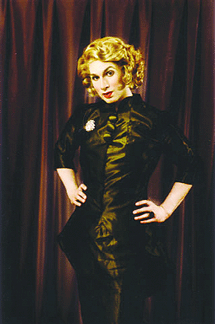Lip-synching history in “Christine Jorgensen Reveals”
“Hello, and here and now, is the first and only recorded interview with Christine Jorgensen.”
So begins a fascinating real-life Q&A recorded in 1958 between an interviewer identified only as Mr. Russell, and the world’s first famous—and perhaps most misunderstood—transsexual, now brought to life in “Christine Jorgensen Reveals,” Bradford Louryk’s extraordinary lip-synched re-creation of that historic interview.
“EX-GI BECOMES BLONDE BOMBSHELL,” screamed the Daily News headline when the news first broke on December 1, 1952, that a Bronx-born man named George Jorgensen, who had done his Army service at Fort Dix in New Jersey, had gone to Denmark for what is now called sex reassignment surgery. When, six weeks later, Christine Jorgensen stepped off the plane at Idlewild—now Kennedy—Airport, she was mobbed by hundreds of curious reporters, photographers, and autograph hounds.
Surprised as she was, Jorgensen, a nightclub performer, answered their questions with grace and class, qualities that Louryk captures perfectly in his stage performance and in his look, beautifully designed by Mary Ping—silk suit, sheer hose, high heels, sparkling jewelry, and a mink stole, accentuated by Jorgensen’s signature bleach-blonde coif, dark arched eyebrows, and red lips and nails.
Seated for the interview in an elevated director’s chair, Louryk’s Jorgensen is composed, articulate, and utterly authentic as she answers Mr. Russell’s questions. “I am more of a woman than I am a man,” she tells him. Explaining that, from childhood she had always felt different, she says she had little choice about making what Russell calls “the transformation. “I would have gone on existing had I not had this treatment,” Jorgensen tells him, “but I would not have gone on living.”
Jorgensen patiently explains that no, she cannot have children—“I am in the position right now of a woman who has had a hysterectomy”—and no, when she sees a beautiful woman she does not wish she could, in Russell’s words, “go back and be a man.” Jorgensen cannot help rolling her eyes ever so slightly, however, when, upon learning that she is quite attracted to men, a leering Russell suggests, “Let’s dance.”
It was surprising to see, in that era, just how candid Jorgensen was about both her medical and psychiatric treatments, and striking to hear her assert well before the gay liberation movement that “It is society’s thinking towards homosexuals that is the problem, not homosexuality itself.”
The original interview upon which this show is based was recorded on audio only, but for this production Mr. Russell is portrayed on black-and-white videotape by the actor Rob Grace, who lip-synchs to a digitally-enhanced version of the 1958 recording. And that is the one puzzling aspect of this otherwise impeccable production—Mr. Russell, it turns out, was the young Nipsy Russell, an African-American who would eventually become a well-known comedian. While Josh Hecht deserves praise for his direction of a man playing a woman who used to be a man, it is hard to understand why he portrayed Mr. Russell as a white man.
gaycitynews.com


































